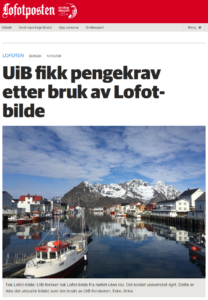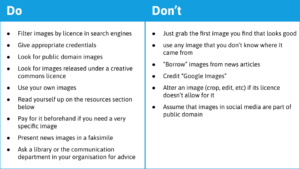
Photo: Matilda Hallerstig 2021. Licence: CC BY-SA 4.0
“But I just need a quick image for my lecture/online article”
Once upon a time, a researcher at the University of Bergen was creating a workshop event page at the University’s website. The researcher needed a photo to illustrate the area of interest for the workshop, so (s)he did what most of us do; quickly grabbed one from the internet and published it. Everything seemed fine, but a few months later, the university got a bill of 23,000 NOK (approximately 2300 EUR) for illegal use of the photo. This was later referred to as the “Lofoten incident”, since the photo was from Lofoten. But there are more cases. Another researcher, a senior scientist at the Bjerknes Center for Climate Research, was preparing a lecture referring to some specific events. To illustrate the lecture, our colleague “borrowed” a few images from a news article about the events. The lecture was good, and both the lecturer and the audience were satisfied. Then a company called “Copyright Agent” contacted the lecture holder saying that they had to pay for unauthorized use of the image. Just as the Lofoten incident, it all ended up costing several times more than it would have if they had asked for permission beforehand. Had the two scientists just had a little bit more knowledge about immaterial rights, they would probably have been able to find suitable legal illustrations without paying anything at all, or at the very least, paying a lot less.
What our colleagues did not know was that by default, creators of any immaterial products such as figures, texts and music, own their creations. That means that no one else is allowed to share, distribute or publish the work without the creator’s permission. Creators can also sell or give away the ownership of their work to others. It is possible to ask owners for permission directly, but many of them release their work under a licence so that anyone can use it as long as they comply with that licence.
A popular licence that is free of charge is Creative Commons. It comes in different versions that may or may not allow you to modify the image, for example by cropping, but most of them require that you credit the creator by adding their name and a link to the original file. In most cases credit is easiest to do by adding a caption that says “Photo: Name of photographer, link to image, link to licence”, as in the cover photo above. In addition, there are two categories of images that are excepted from the copyright rules above. Those images can be used, modified and distributed as you want without asking for permission or adhering to a licence.
The first exception is the Public Domain. All material older than a certain age automatically belongs here. That age varies between countries, but in Norway and the European Union, it is 70 years after the creator of the image died. Many public organisations and institutions also place their material in the Public Domain.
The second exception is images that do not reach the threshold of originality. That means images that are considered too simple to be a work of art. This may be a bit tricky to determine, but automatic photos from webcams fall in this category. So do simple geometrical shapes.

Facsimile: Lofotposten, 2019-01-09, Mads Trellevik
For our unfortunate colleagues, it would have been fairly easy to find a suitable photo of Lofoten by filtering the image search by licence. This is a feature in both google images and flickr. There are also special image banks for images that can be used for free. To include photos from a specific event in a presentation, the other researcher could have used something called a facsimile. That means using a screenshot of the actual news-article as in the figure to the right, instead of ripping its photos out of context. Be sure to add a caption with information about where the article comes from, such as the name of newspaper, date published, link to original article, and if applicable, the name of photographer and author of article.
Finally, if you absolutely need a specific image, and there is no free legal option, it is much better to ask and pay for permission beforehand, than getting fined for illegal use afterwards. Such permission usually costs around 1000 NOK, but can go as high as 10 000 NOK, especially for images from large international companies. That said, your university or organization may already have a deal with an image bank, so it is worth checking with the communication department or administration where you work before making any agreements on your own. For example, the University of Bergen has an agreement with NTB, which is the largest Norwegian press photo bank.
Once you are aware of these copyright rules and know what to look for when you search for images, it will be relatively easy to find suitable illustrations that are both legal and free of charge. It takes a lot of time and effort to create good images, so let’s show appreciation to the creators of images by respecting the copyright laws. After all, a somewhat relevant legal image is better than a very relevant stolen image (or no image at all).

Disclaimer
None of the writers of this text are experts on legislation. We are simply two persons within the scientific community who want to raise awareness about the issue. Also, laws are different in different countries and we wrote this text in a Norwegian context. In other words, it is not our responsibility if you get caught. It is always the publisher. That said, if you have read this far, you already have some knowledge, and if you spend an hour or two on the resources below, you will probably know more about the topic than most of your colleagues.
Resources (mostly in Norwegian)
Creative Commons (English)
Researcher Gisle Hannemyr´s online handbook in use of images and video as intellectual property in Norway (Norwegian)
UiB on copyright in education (Norwegian)
UiB on copyright of your own and others work (English)
Public Broadcaster Technology blog NRKbeta (Norwegian)
The Norwegian Copyright Act (Norwegian)
Image banks
Paid option:
NTB, the largest Norwegian press photo bank
Free options:
Flickr (remember to use «All creative commons» in search)
Wikimedia Commons (check files for usage rights)
The UiB historical image collection, MARCUS
All federal US scientific institutions, and most EU ones (as well as others) also have media banks in the public domain/creative commons. Some of these have Flickr pages, some their own pages:
NASA, NOAA, ESA, etc.
University Flickr pages
Bjerknes Centre, UiB, Faculty







